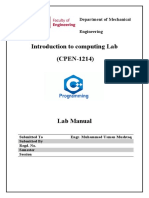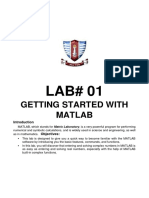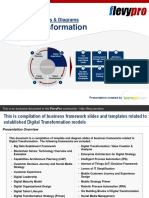Lab No. 04
Lab No. 04
Uploaded by
rosina.pansino003Copyright:
Available Formats
Lab No. 04
Lab No. 04
Uploaded by
rosina.pansino003Original Title
Copyright
Available Formats
Share this document
Did you find this document useful?
Is this content inappropriate?
Copyright:
Available Formats
Lab No. 04
Lab No. 04
Uploaded by
rosina.pansino003Copyright:
Available Formats
LAB NO.
04 DATE: 12/09/2023
HOW TO CREATE PRIMARY and FOREIGN KEYS IN MS SQL
SERVER
Lab outcomes:
After completing this lab, students will be able to:
Know about Microsoft SQL server
Know about SQL server management studio
Create table in SQL server
Create primary and foreign keys
Corresponding CLO and PLO:
CLO-1, PLO-3(Design and Development solutions)
SOFTWARE REQUIRED:
Microsoft SQL server
SQL server management studio
Theory:
Primary Key:
A Primary key is a unique column we set in a table to easily identify and locate data in
queries. A table can have only one primary key. The primary key column has a unique value
and doesn’t store repeating values. A Primary key can never take NULL values.
For example, in the case of a student when identification needs to be done in the class, the
roll number of the student plays the role of Primary key. Similarly, when we talk about
employees in a company, the employee ID is functioning as the Primary key for
identification.
Let us now understand the Syntax of creating the table with the Primary key specified.
Syntax:
CREATE TABLE tableName (
col1 int NOT NULL,
col2 varchar(50) NOT NULL,
col3 int,
…………….
PRIMARY KEY (col1) );
What is a Foreign key in SQL?
A Foreign key is beneficial when we connect two or more tables so that data from both can
be put to use parallel. A foreign key is a field or collection of fields in a table that refers to the
Primary key of the other table. It is responsible for managing the relationship between the
tables. The table which contains the foreign key is often called the child table, and the table
whose primary key is being referred by the foreign key is called the Parent Table.
For example: When we talk about students and the courses they have enrolled in, now if we
try to store all the data in a single table, the problem of redundancy arises.
To solve this table, we make two tables, one the student detail table and the other department
table. In the student table, we store the details of students and the courses they have enrolled
in. And in the department table, we store all the details of the department. Here the courseId
acts as the Primary key for the department table whereas it acts as the Foreign key in the
student table.
Syntax:
CREATE TABLE childTable (
col1 int NOT NULL,
col2 int NOT NULL,
col3 int,
………...
PRIMARY KEY (col1),
FOREIGN KEY (col3) REFERENCES parentTable(parent_Primary_key));
Creation of Parent Table DataFlair:
Query:
CREATE TABLE DataFlair(
emp_id varchar(5) NOT NULL,
name varchar(50),
location varchar(50),
experience int,
PRIMARY KEY(emp_id));
Output:
Figure 1: Assigning primary key
Lab Task:
Task 1:
1) Create a Primary Key and Foreign Key for two tables i.e. Student’s Table and
Subject’s Table also add the procedure (query) and output screenshots with the
lab task.
Solution:
Student Table Query:
Student Table Output:
Subject Table Query:
Subject Table Output:
Conclusion:
In this lab, I learned about primary keys and how to reference them using foreign keys.
Rubrics:
Report not Plagiarized Requirements Observations Appropriate Correctly
submitted content are listed and are recorded computation drawn
presented or experimental along with s or conclusion
Laboratory incomplete procedure is detailed numerical with
Reports submission or presented procedure analysis is exact results
late performed and complete
report in all
respects
Category Ungraded Very Poor Poor Fair Good Excellent
Marks 0 1 2 3 4 5
Date Total Marks Instructor’s Signature
Absent Student failed Student Student Student Student
to develop a developed a developed a developed a excelled in
functional partially mostly fully developing
code or functional functional functional fully
complete the code and code and met code and functional
lab objective struggled to the lab met the lab code,
within the accomplish objective objective exceeding
simulation the lab within the within the expected
environment. objective simulation simulation results within
They exhibit within the environment, environment simulation
inadequate simulation achieving , achieving environment.
understanding environment. satisfactory expected They
Demonstrat
in They results. They results. demonstrate
ion
configuring, demonstrate exhibit They mastery in
operating, and minimal moderate demonstrate independently
executing the understanding proficiency in proficiency configuring,
simulation in configuring, in operating and
independently configuring, operating, and configuring, executing the
. operating, and executing the operating, simulation.
executing the simulation and
simulation independently executing
independently . the
. simulation
independent
ly.
Category Ungraded Very Poor Poor Fair Good Excellent
Marks 0 1 2 3 4 5
Date Total Marks Instructor’s Signature
You might also like
- Digital Skills and Personal Development Assignment WorkDocument18 pagesDigital Skills and Personal Development Assignment Workheeducationalservices0% (1)
- Sac Training Guide 2019 Final PDFDocument49 pagesSac Training Guide 2019 Final PDFArmando Santos100% (1)
- Ph. No. 872-395-2037: Muhammad Usman Sr. Vmware/Windows /wintel EngineerDocument5 pagesPh. No. 872-395-2037: Muhammad Usman Sr. Vmware/Windows /wintel EngineerxovoNo ratings yet
- Introduction To Computing Lab (CPEN-1214) : Department of Mechanical EngineeringDocument32 pagesIntroduction To Computing Lab (CPEN-1214) : Department of Mechanical EngineeringAbdullah SahirNo ratings yet
- McQuay ALS PFS C Technical Manual Eng PDFDocument72 pagesMcQuay ALS PFS C Technical Manual Eng PDFAdolfo Riquelme Novoa100% (2)
- Lab No. 03Document6 pagesLab No. 03rosina.pansino003No ratings yet
- Lab No. 1Document6 pagesLab No. 1rosina.pansino003No ratings yet
- Rubrics of LCS Simulation LabDocument2 pagesRubrics of LCS Simulation LabAdil ZohaibNo ratings yet
- Lab 18Document5 pagesLab 18Fazool FarighNo ratings yet
- Basics of Java ProgrammingDocument63 pagesBasics of Java Programmingvinay_manoliNo ratings yet
- Lab 13Document5 pagesLab 13Fazool FarighNo ratings yet
- Ooj Prac 3 - 30Document5 pagesOoj Prac 3 - 30ABCD EFGNo ratings yet
- OOP Lab 01Document10 pagesOOP Lab 01muhammad zafarNo ratings yet
- Lab 7Document5 pagesLab 7ranahassanirfan2005No ratings yet
- Lab 09Document4 pagesLab 09ranahassanirfan2005No ratings yet
- AICT Lab Manual StartingPages 2023Document12 pagesAICT Lab Manual StartingPages 2023murtazaalisyed456No ratings yet
- Faculty of Engineering: Receipt of Lab Report Submission (To Be Kept by Student)Document10 pagesFaculty of Engineering: Receipt of Lab Report Submission (To Be Kept by Student)Mahamed HusseinNo ratings yet
- Lab #2Document5 pagesLab #2Mugheera MalikNo ratings yet
- Laboratory 4Document6 pagesLaboratory 4Kevin TusiNo ratings yet
- Lab Manual, RoboticsDocument36 pagesLab Manual, RoboticsGohar RahogNo ratings yet
- Lab 6Document5 pagesLab 6Fazool FarighNo ratings yet
- FoCP Lab Manual 13Document5 pagesFoCP Lab Manual 13msarfraz.bscs23seecsNo ratings yet
- Data Structure and Algorithms Lab Manuel in C++Document120 pagesData Structure and Algorithms Lab Manuel in C++ahsankamran613No ratings yet
- Updated microcontroller-lab-EC-606Document31 pagesUpdated microcontroller-lab-EC-606Yash raiNo ratings yet
- Introduction To Command Line in Ubuntu Linux.: Lab No. 3 29/3/2023Document11 pagesIntroduction To Command Line in Ubuntu Linux.: Lab No. 3 29/3/2023Muhammad HassanNo ratings yet
- PW1 Dec20012Document13 pagesPW1 Dec20012Yanrou KoNo ratings yet
- 05 - Mpi - ShuDocument10 pages05 - Mpi - ShuUsama Javed100% (1)
- Database Systems LabDocument33 pagesDatabase Systems LabMuhammad ALi Fall-22-BSCS-229No ratings yet
- 03 - MPI - SHU (Usama)Document11 pages03 - MPI - SHU (Usama)Usama JavedNo ratings yet
- Csc103 PF Lab Manual Sp22 v3.1Document133 pagesCsc103 PF Lab Manual Sp22 v3.1fa22-bse-051No ratings yet
- Ooj Prac 2 - 30Document4 pagesOoj Prac 2 - 30ABCD EFGNo ratings yet
- CSC351_Lab_Manual_Database SystemsDocument89 pagesCSC351_Lab_Manual_Database SystemsabdullahzahidhpNo ratings yet
- Dbms Lab 1 To 9 My MuneerDocument85 pagesDbms Lab 1 To 9 My MuneerMuneer KingNo ratings yet
- Oel #2pf Lab Spring 2023.Document3 pagesOel #2pf Lab Spring 2023.Talha TariqNo ratings yet
- Design ExperimentDocument16 pagesDesign ExperimentCHRISTED ALJO BARROGANo ratings yet
- 04 - MPI - SHU (Modify)Document14 pages04 - MPI - SHU (Modify)Usama Javed100% (1)
- Basic Electronics Lab (GE101) Manual (11) - 1Document32 pagesBasic Electronics Lab (GE101) Manual (11) - 1chihsanzahidNo ratings yet
- Pw2 - Dec30043 Nazri and AmirulDocument14 pagesPw2 - Dec30043 Nazri and Amirul4tbkv48bpbNo ratings yet
- Operating System ManualDocument48 pagesOperating System ManualabdulNo ratings yet
- Advanced Java ProgrammingDocument4 pagesAdvanced Java ProgrammingArulVenkatachalamNo ratings yet
- Lab #3Document4 pagesLab #3Mugheera MalikNo ratings yet
- LAB 1 MatlabDocument8 pagesLAB 1 MatlabM AzeemNo ratings yet
- Lab No 1Document26 pagesLab No 1MariumraisNo ratings yet
- Laboratory Activity 2 - Bisection MethodDocument7 pagesLaboratory Activity 2 - Bisection MethodART JACOSALEMNo ratings yet
- Performance Indicators Beginner 1 Acceptable 2 Proficient 3 Scor E Laboratory PerformanceDocument12 pagesPerformance Indicators Beginner 1 Acceptable 2 Proficient 3 Scor E Laboratory PerformanceBla NkNo ratings yet
- Basic Electronics Lab (GE101) ManualDocument26 pagesBasic Electronics Lab (GE101) ManualmaliktalhakhokharofficialNo ratings yet
- 02 - Mpi - ShuDocument15 pages02 - Mpi - ShuUsama JavedNo ratings yet
- Algorithms and Data Structures Final Lab ExamDocument3 pagesAlgorithms and Data Structures Final Lab ExamMuhammadHadiNo ratings yet
- Mpi Lab No 7Document6 pagesMpi Lab No 7Muhammad Waleed KhanNo ratings yet
- Rubric SDocument4 pagesRubric SVikas MahorNo ratings yet
- Data Warehousing and Data Mining LabDocument63 pagesData Warehousing and Data Mining Labdhruvikamra26No ratings yet
- Java Lab SyllabusDocument11 pagesJava Lab Syllabuspranaybhandare765No ratings yet
- Lab 1 Utk PelajarDocument2 pagesLab 1 Utk Pelajarfarisya faizNo ratings yet
- Information and Communication Technology 9 Junior High School 25&26Document5 pagesInformation and Communication Technology 9 Junior High School 25&26ruclito morataNo ratings yet
- Lab 7Document5 pagesLab 7Nomi AliNo ratings yet
- Lab 01 MP MCDocument6 pagesLab 01 MP MCRizwan LatifNo ratings yet
- Java OopDocument4 pagesJava OopMohammed ElmadaniNo ratings yet
- LP TLE PCO-browserDocument6 pagesLP TLE PCO-browserThea PinesNo ratings yet
- F1 PDFDocument16 pagesF1 PDFHumairah ShabriNo ratings yet
- Control System Lab Manual V 1Document173 pagesControl System Lab Manual V 1Engr. M. Farhan Faculty Member UET Kohat100% (1)
- Assignment Guideline and Rubric CPC251Document3 pagesAssignment Guideline and Rubric CPC251nhmnirhNo ratings yet
- The-Complete-Guide-to-Understanding-Swift-OptionalsDocument50 pagesThe-Complete-Guide-to-Understanding-Swift-OptionalsCagriNo ratings yet
- Programming With Java Lab Manual(b22ci0407)(6)Document54 pagesProgramming With Java Lab Manual(b22ci0407)(6)Lakshmi pathiNo ratings yet
- ThinkCentre-M73-DatasheetDocument5 pagesThinkCentre-M73-Datasheetjz02bnkNo ratings yet
- Emtech First Quarter ExamDocument3 pagesEmtech First Quarter ExamGemmaAlejandroNo ratings yet
- Flevy 183Document59 pagesFlevy 183Debashish Ghosh100% (2)
- Quarter 2 Week 3 Argumentative Essay 1 ModalsDocument34 pagesQuarter 2 Week 3 Argumentative Essay 1 ModalshypnoticminecraftgamingNo ratings yet
- Edureka Training - Selenium Certification Training CourseDocument11 pagesEdureka Training - Selenium Certification Training CourseDhruva ReddyNo ratings yet
- 01 PI Planning Simulation Remote Aid (6.0)Document96 pages01 PI Planning Simulation Remote Aid (6.0)dcbckp09No ratings yet
- Report Bachelors Assignment Arvid Jense Meeblip SynthesizerDocument102 pagesReport Bachelors Assignment Arvid Jense Meeblip SynthesizerDenny George100% (1)
- ICS Cyber Incident Response POSTERDocument2 pagesICS Cyber Incident Response POSTERAni MNo ratings yet
- Power Bi Overview and Project Showcase - UpdatedDocument20 pagesPower Bi Overview and Project Showcase - UpdatedndthesinghNo ratings yet
- Computer Science Final Project - After EditingDocument36 pagesComputer Science Final Project - After Editingg.r.tejni2006No ratings yet
- BassmixDocument6 pagesBassmixgrasyNo ratings yet
- Application Log DisplayDocument69 pagesApplication Log Displayshammi_manchandaniNo ratings yet
- How To Build A PC - Informative SpeechDocument6 pagesHow To Build A PC - Informative SpeechMuhammad AshmanNo ratings yet
- SUSE Manager 3.1 Advanced TopicsDocument188 pagesSUSE Manager 3.1 Advanced TopicspotrosniNo ratings yet
- Magic Quadrant For CRM Lead ManagementDocument14 pagesMagic Quadrant For CRM Lead Managementabhik167No ratings yet
- Edureka Training - DevOps Engineer Masters ProgramDocument39 pagesEdureka Training - DevOps Engineer Masters Programderegos526No ratings yet
- SECTION5940Document13 pagesSECTION5940Franklin Manolo NiveloNo ratings yet
- File 3Document12 pagesFile 3DavidNo ratings yet
- XML To DataframeDocument6 pagesXML To DataframeRaghavender ReddyNo ratings yet
- The Inevitability of Cloud-Based Case Management For Regulated EnterprisesDocument6 pagesThe Inevitability of Cloud-Based Case Management For Regulated EnterprisesOpen Access JournalNo ratings yet
- TL-WN722N (EU&US) 3.0 Datasheet PDFDocument4 pagesTL-WN722N (EU&US) 3.0 Datasheet PDFThe Kronos Place100% (1)
- BadiDocument2 pagesBadirajeshwariNo ratings yet
- 4 (A) .Drag and Drop HTML5 APIDocument40 pages4 (A) .Drag and Drop HTML5 APIvigneshNo ratings yet
- Object Oriented ConceptsDocument11 pagesObject Oriented ConceptsAditya SharmaNo ratings yet
- Configuring SPNEGO Based SSO With Websphere and Active DirectoryDocument4 pagesConfiguring SPNEGO Based SSO With Websphere and Active DirectoryImmanuel AristyaNo ratings yet
- Exam Questions AWS-Solution-Architect-AssociateDocument6 pagesExam Questions AWS-Solution-Architect-Associatehanuman challisaNo ratings yet

























































































